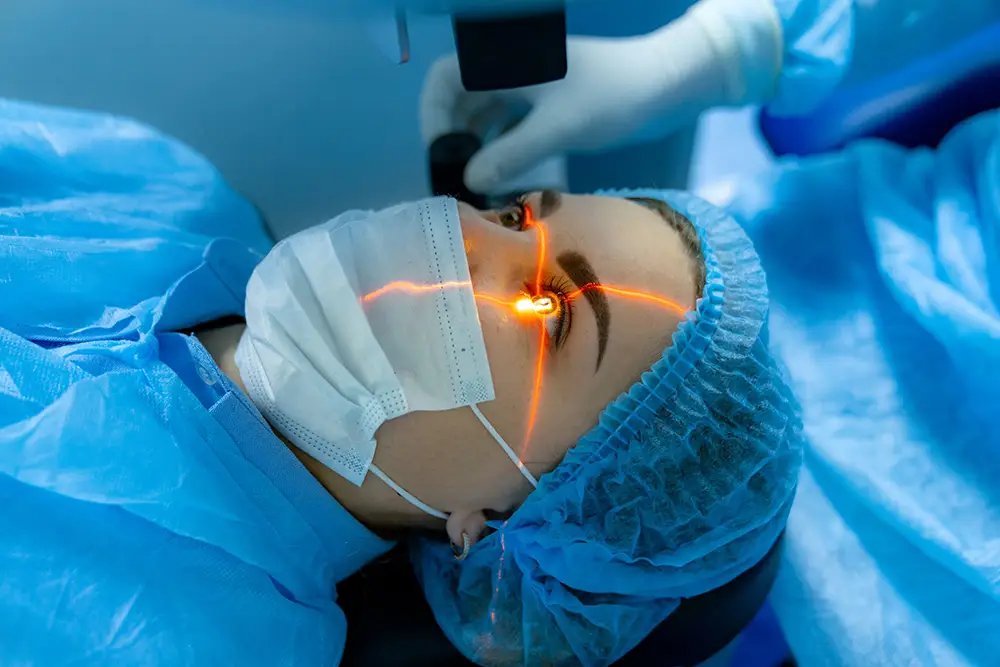Do you struggle to see things up close? Do your eyes feel tired after reading or using your phone? Well, you might be dealing with farsightedness, also known as hyperopia. This common vision problem can make daily tasks difficult and frustrating.
In this blog, we’ll dive into everything you need to know about farsightedness. You’ll learn what it is, the signs to look out for, what causes it, and explore the different ways to treat it.
So let’s get started and explore how to improve your vision and quality of life.
Contents
What is Hyperopia or Farsightedness?
Hyperopia, also known as farsightedness or long-sightedness, is a common vision problem where you can see distant objects clearly, but nearby objects appear blurry. This happens because the light entering your eye focuses behind your retina instead of directly on it.
Common Symptoms of Farsightedness

- Difficulty focusing on close objects
- Eye strain
- Headaches
- Blurred vision for nearby tasks
- Fatigue after reading or using digital devices
- Squinting to see better
- Discomfort or pain around the eyes
Causes of Farsightedness
Farsightedness, or hyperopia, occurs due to several underlying factors. Some of them include:
- Inherited Condition: This means that it can be passed down from parents to children.
- Shorter Eyeball: One of the primary causes of farsightedness is a shorter-than-normal eyeball. This causes light to focus behind the retina instead of directly on it.
- Flat Cornea: The cornea, the clear front surface of the eye, maybe too flat, preventing light from bending properly and focusing correctly on the retina.
- Lens Problems: The lens inside the eye may not be curved enough, causing light to focus incorrectly.
These anatomical issues prevent the eye from focusing light directly onto the retina, leading to blurry vision for nearby objects while distant objects remain clear.
Hyperopia vs Myopia vs Hypermetropia
| Condition | Definition | How Vision is Affected | Focal Point of Light | Common Symptoms |
|---|---|---|---|---|
| Hyperopia (Farsightedness) | A condition where distant objects are clear, but close objects are blurry. | Difficulty focusing on close objects. | Light focuses behind the retina. | Eye strain, headaches, blurred vision for nearby tasks. |
| Myopia (Nearsightedness) | A condition where close objects are clear, but distant objects are blurry. | Difficulty seeing distant objects. | Light focuses in front of the retina. | Squinting, eye strain, headaches, difficulty seeing far away. |
| Hypermetropia | Another term for farsightedness; often used interchangeably with hyperopia. | Same as hyperopia. | Same as hyperopia. | Same as hyperopia. |
Diagnosing Farsightedness

Farsightedness, or hyperopia, is diagnosed through a comprehensive eye exam performed by an optometrist or ophthalmologist.
The eye doctor will start by asking about your medical history and any vision problems you are experiencing. Then , you’ll be going under few visual tests, including,
- Visual Acuity Test: This test measures how well you see at different distances using an eye chart. You’ll be asked to read letters or symbols from a chart placed at a specific distance.
- Refraction Test: The doctor uses a phoropter and a retinoscope to determine your exact prescription. This involves looking through different lenses to see which ones give you the clearest vision.
- Autorefractor: This machine measures how light changes as it enters your eye, helping to determine your prescription.
- Slit-Lamp Exam: A special microscope called a slit lamp is used to examine the structures of your eye, including the cornea, lens, and retina, to ensure there are no other issues.
These tests help the eye doctor understand how well your eyes focus light and whether you have farsightedness. Based on the results, they can prescribe corrective lenses or suggest other treatment options to improve your vision.
Treatment Options for Farsightedness

- Eyeglasses: Glasses are the simplest and most common way to correct farsightedness. They help focus light correctly onto the retina, improving near vision.
- Contact Lenses: These lenses are comfortable and easy to wear. They correct farsightedness by adjusting the focus of light entering the eye.
- Surgical Treatment:
- LASIK (Laser-Assisted In Situ Keratomileusis): A popular surgical option that reshapes the cornea to correct the way light focuses on the retina. It is a quick and effective procedure with a short recovery time.
- Lens Implants: In some cases, an artificial lens can be implanted to correct severe farsightedness, especially for those who cannot undergo laser surgery.
Each of these treatment options has its benefits and considerations. Consulting with an eye care professional can help determine the best option based on individual needs and eye health.
Preventing Farsightedness
Farsightedness, or hyperopia, is largely influenced by genetics and the natural aging process, which makes it challenging to prevent entirely. However, maintaining good eye health can help reduce the risk and manage overall vision health. Here are some tips to help protect your eyes:
- Eat a diet rich in fruits, vegetables, and omega-3 fatty acids to support eye health.
- Drink plenty of water
- Wear sunglasses that block UV rays to protect your eyes from sun damage
- Follow the 20-20-20 rule to reduce eye strain.
- Ensure adequate lighting when reading or using digital devices to minimize eye strain.
- Quit Smoking
- Practice simple eye exercises to strengthen eye muscles and reduce eye strain, especially if you spend long periods on close-up tasks.
While you may not be able to prevent farsightedness completely, these practices can help maintain good eye health and potentially reduce the risk of developing or worsening hyperopia.
Conclusion
Don’t let blurry vision hold you back any longer. If you’re tired of struggling with farsightedness and are seeking a solution, LASIK surgery could be the answer. At EyeMantra Foundation, we offer state-of-the-art LASIK procedures designed to give you the freedom of clear, sharp vision.
Ready to see the world with clarity? Call us at +91 9711116605 and Book your free appointment with EyeMantra Foundation today.
